Long White Gypsy uses affiliate links and is a member of the Amazon Services LLC Associates Program. If you make a purchase using one of these links, I may receive a small commission at no extra cost to you. See my Privacy Policy for more information.
Are you an avid hiker looking for the best attire to wear out on the trails?
If so, you may have been debating whether to go hiking in running shorts or hiking pants on your next excursion.
While both pieces of clothing can provide comfort and protection from the elements, some key differences between them should be taken into consideration before making a decision.
In this blog post, we’ll explore the pros and cons of wearing running shorts versus hiking pants out on the trails as well as how each piece of clothing affects performance and safety while out on the trail.

Why is hiking in running shorts a good idea?
For beginner hikers, wearing running shorts can be a great choice for staying comfortable and protected on the trail.
Running shorts are lightweight, and breathable and often come with features such as pockets for storing small items or reflective detailing to make you more visible in low-light conditions.
Additionally, they offer greater freedom of movement than pants, allowing you to move quickly and easily over rough terrain without feeling restricted.
Finally, since running shorts are usually made from synthetic materials that wick away moisture quickly and efficiently. This not only protects you from the elements in a downpour but also keeps you cool when temperatures rise during the summer months.
the Benefits of hiking in running shorts.
Here are some of my favourite benefits of hiking in running shorts, and why I think you’ll like them too:
- Lightweight and breathable – Synthetic fabrics and materials are lighter and more breathable than traditional hiking shorts or pants, for greater comfort. Bonus: This means they also weigh less in your pack!
- Reflective detailing – Some running shorts have in-built reflectors, making you more visible when hiking at night, in low-light or on roads.
- More freedom of movement – Your legs have more space and less restriction to move freely and quickly over rough terrain.
- Moisture-wicking properties – Running shorts quickly wick away moisture to protect you from downpour, and keep you cool in the hot summer months
- Comfort – Running shorts are more comfortable due to the lightweight fabric that won’t weigh you down while trekking.
- Quick-drying – They easily dry when wet, so they can be washed multiple times to keep fresh and free of grime.
- Smaller and more compact – This makes them ideal for packing on long hikes with limited storage space.
- Easy to layer – Bulky layers may be too warm and uncomfortable in some conditions, so follow the rules of the outdoor code and layer up! Tights and long johns easily turn hiking shorts into a cold-weather alternative.
- Less chaffing – Running shorts cause less skin irritation as there’s less friction against your skin compared to wearing pants.
- Less cost – Running shorts are generally cheaper than hiking pants, because they’re used more frequently by the general population and not so ‘specialist’.
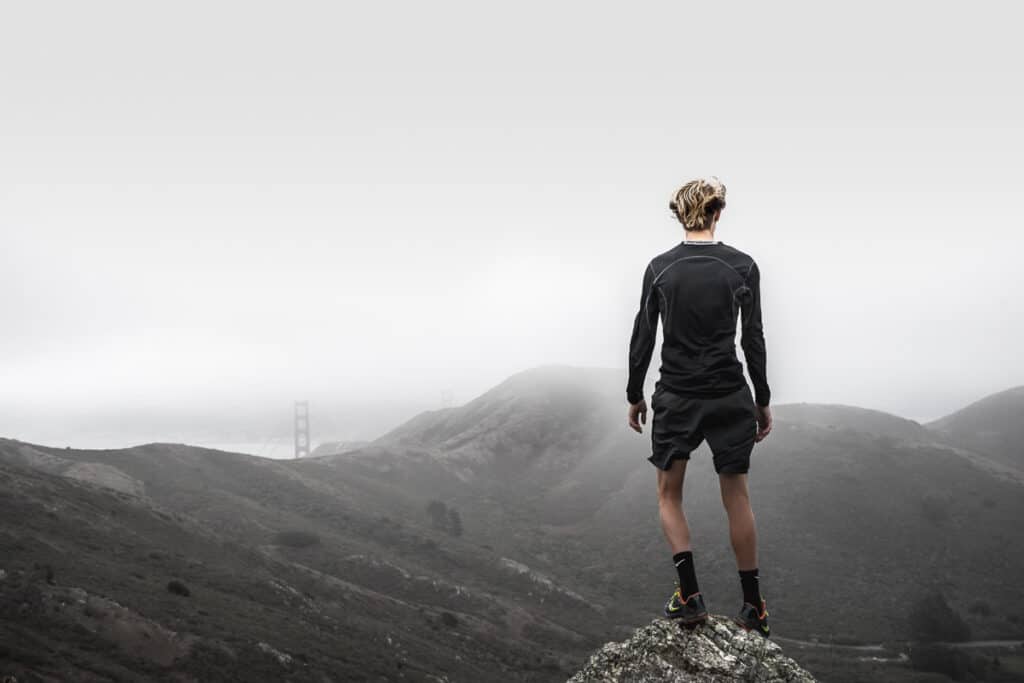
the Downsides of hiking in running shorts.
With all upsides, there are always down. Here are some of the most obvious downsides of hiking in running shorts to take into consideration:
- Lack of storage – Unlike traditional hiking pants, running shorts have limited space in which you can store items like snacks, water bottles, and navigation tools, usually having only very small and usually hidden pockets.
- Lack of protection – Whether it’s from the sun, rain (or even bugs!) the reality is that running shorts don’t offer the same level of protection as a pair of pants simply because they are shorter and expose more skin.
- Lack of durability – Running shorts are usually made of lighter and thinner fabrics, so might not be as durable as heavier-duty hiking pants, so they may not stand up to long days of bushbashing and trail work. In these circumstances, hiking pants with more durable fabric may be a better choice.
- Lack of insulation – Running shorts are not ideal for cold weather conditions, as they provide little to no insulation against the elements. In colder climates, you may want to opt for more insulated hiking pants or layer your shorts with a good Baselayer or long johns.
All in all, while running shorts can be a great option for leisurely hikes, they may not be the best choice if you plan on doing any serious hiking in rough terrain.
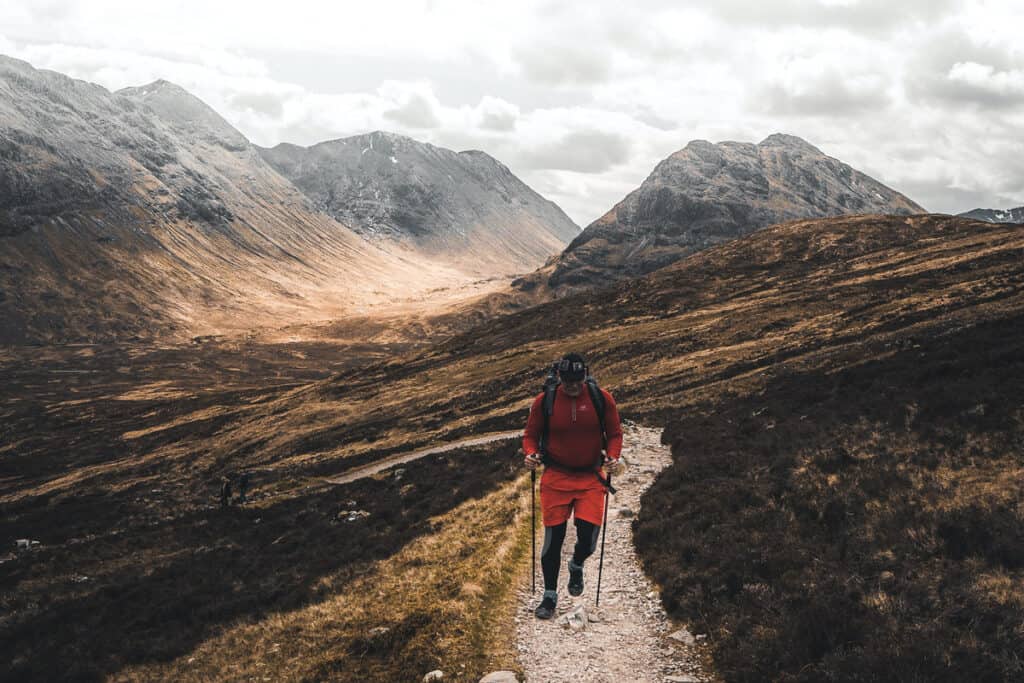
Features to look for in a good pair of running shorts for hiking.
Fabrics/material – Lightweight, breathable fabrics make them comfortable to wear on the trail and can help keep you cool in hot weather conditions.
Shell – The shell is usually made from a combination of synthetic and natural materials that provide durability and protection from the elements. Look for a shell material that offers both breathability and comfort.
Liner – A liner will help keep your skin dry by wicking away moisture, great if you sweat a lot or if it rains. A good liner will keep your skin dry and regulate temperature while preventing chafing or irritation. Liners could take the form of sewn-in briefs or hot pants which also provide added coverage and protection.
Gusset – A gusset panel in the crotch area will provide extra stretchability and flexibility so that you can move freely while hiking. Look for a gusset panel at the crotch area to provide a better range of motion and flexibility.
Length – The length of the shorts (usually referred to as the inseam) depends on your preferences; some hikers like longer shorts while others prefer something shorter. Most male hikers opt for running shorts with an inseam of around 7″ inches. Women’s running shorts aren’t usually defined by their length, but an inseam of 2″ to 5″+ is common.
Quick drying – Quick-drying (usually moisture-wicking) fabrics are a must if you’re going to be out on the trail for an extended period, as it means you can rinse and dry them in a matter of hours. Look for nylons and synthetic fabrics, and stay away from linens and cotton-based fabrics.
Pockets – Many running shorts come with pockets for carrying small items like energy bars, keys, or chapstick. This can be a convenient way to keep your essentials within reach while you’re exploring the outdoors.
Whether you’re hitting the trails for a casual stroll or taking on more difficult terrain, running shorts offer superior comfort and convenience when compared to hiking in pants, regardless of your skill level.

Hiking in running shorts vs hiking in normal shorts.
When it comes to hiking, running shorts are superior to regular shorts for several reasons.
Firstly, running shorts are designed specifically for physical activity and provide greater comfort, flexibility and breathability than normal shorts.
Regular shorts are usually made from heavier fabrics that can make you feel hot and sweaty in warm weather conditions. They also tend to have less give. This is in stark contrast to the lighter, more breathable running short.
Running shorts may also feature a two-in-one layer system, where a pair of tighter shorts or briefs are sewn in underneath the outer loose layer. Not only does this provide more protection, coverage and support, for some hikers it may also mean less need for underwear!
Running shorts usually also come with an elasticated waistband to keep them snugly in place while you’re exploring the great outdoors. Regular shorts usually have a looser waistband that can allow them to slip down as you hike.
To combat this, you might need to wear a belt (which can be more restrictive) but running shorts usually come with an inbuilt elasticated waistband that moves with you whilst you hike. Plus, you won’t need to worry about your pack straps digging into your belt and causing discomfort.
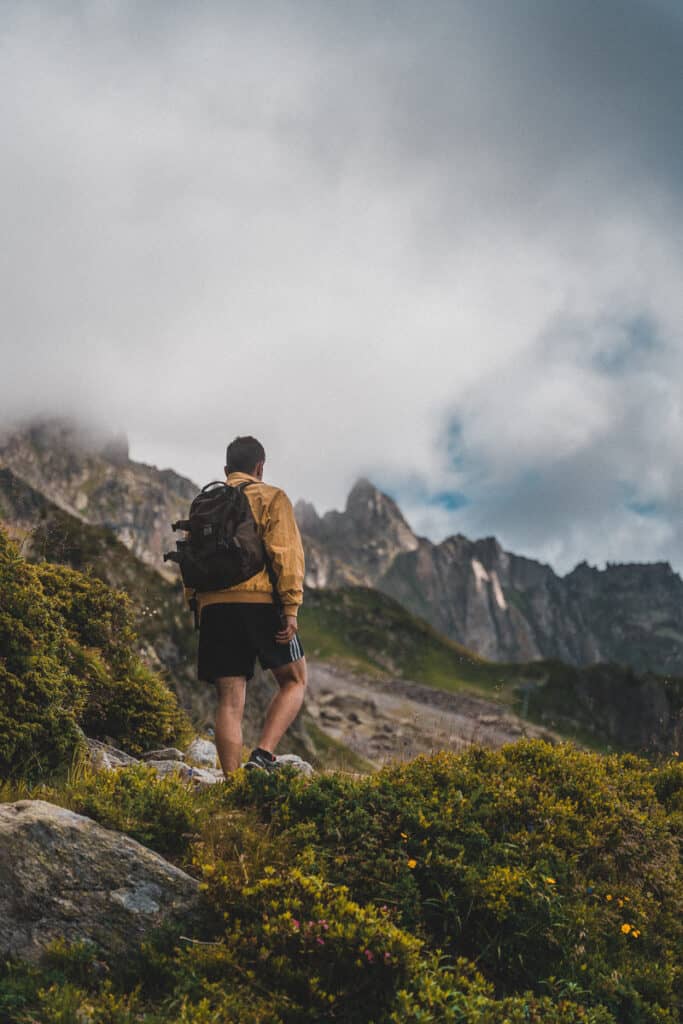
The best running shorts for hiking.
Here are some suggestions of running shorts which are also great for hiking:
Nike Challenger Shorts (for men) — Popular in the thru hiking community, the Challenger shorts are packed with all the features you’d expect in a good running short including a built-in brief liner, elasticated waistband and plenty of pockets.
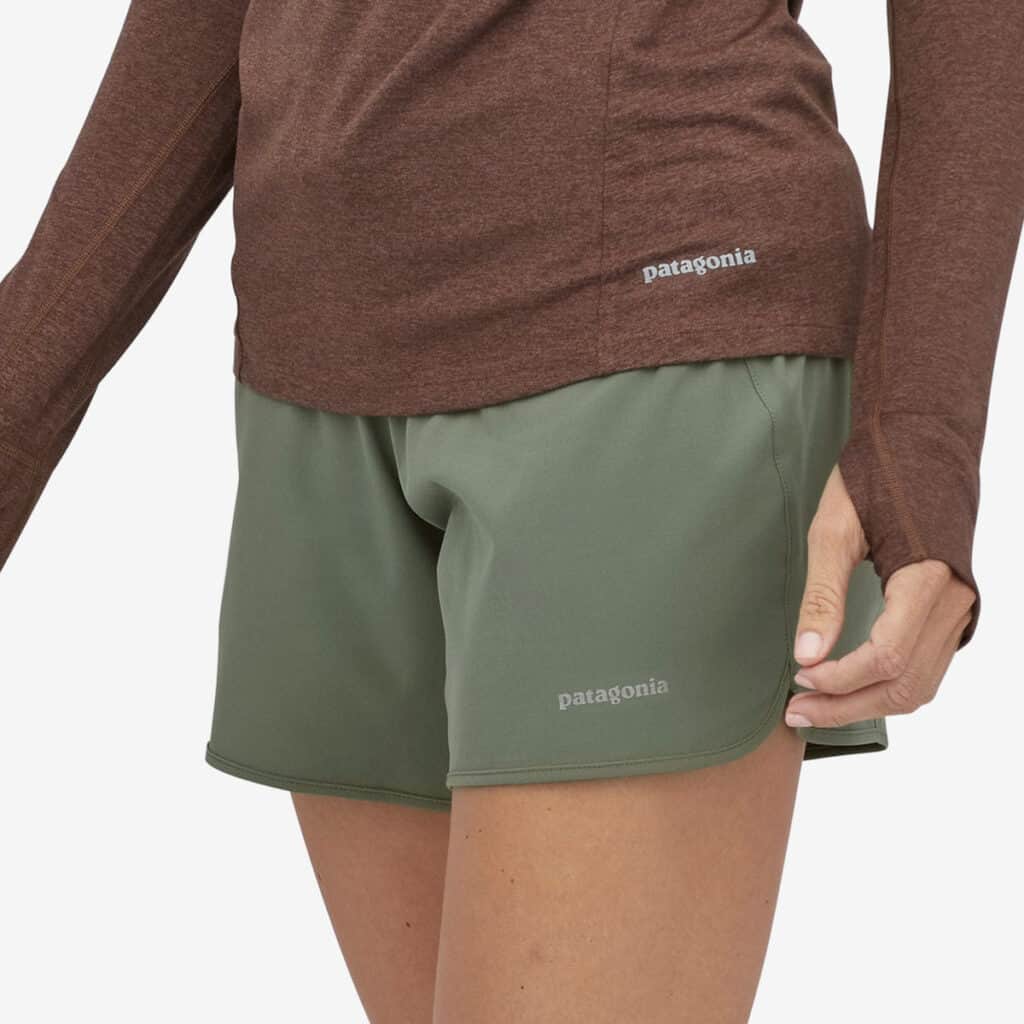
Nike Flex Stride 2 in 1 Shorts (for men) — With a longer 7″ inseam and enhanced breathability, these shorts are made from sustainable recycled materials and feature heaps of pockets.
Nike Flex Essential 2 in 1 Shorts (for women) — Nike flex fabric stretches with your body, features a pocket for storage and skin-hugging inner shorts for coverage & muscle support.
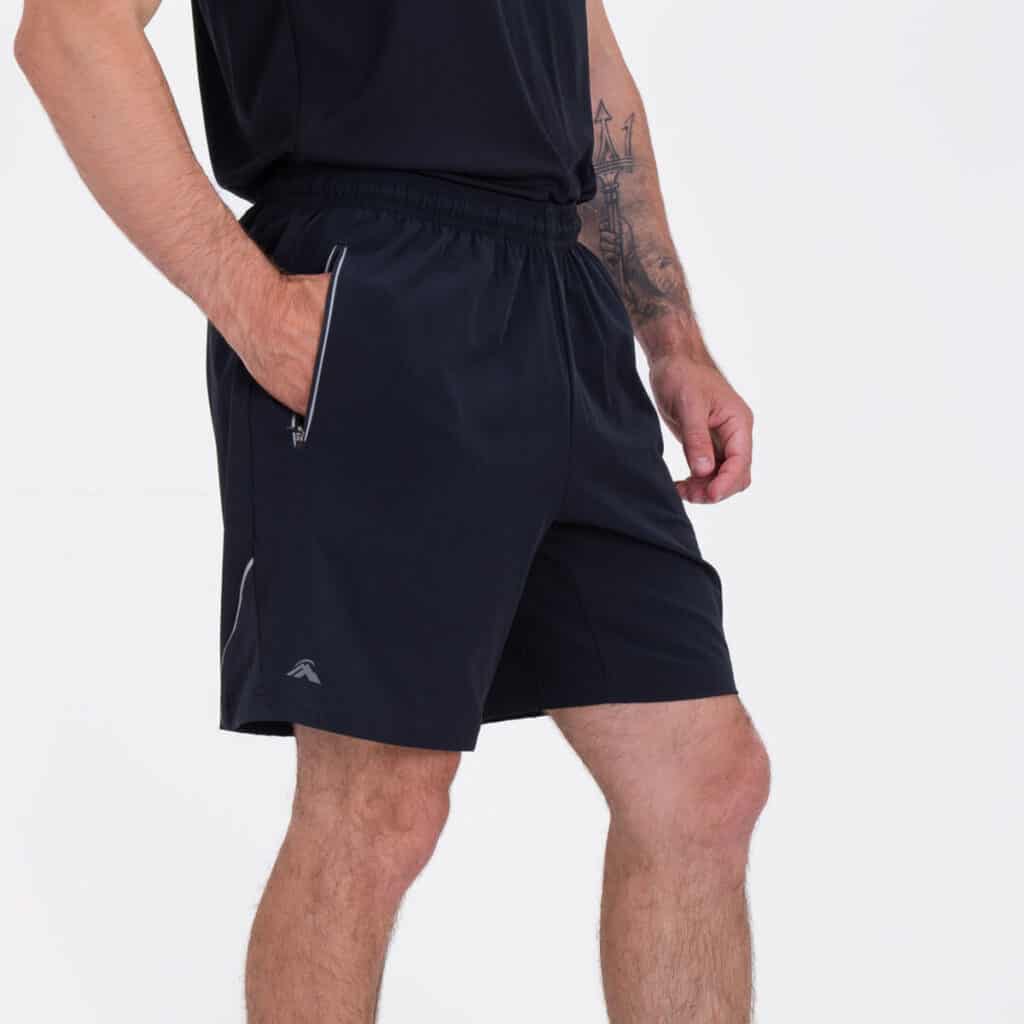
Alternatives to hiking in running shorts.
If you’re unsure about whether running shorts are right for your hike, there are a few other options that you can choose from.
Traditional outdoor pants or hiking pants offer greater coverage and protection from the elements, although they may be less comfortable in hot weather conditions.
Alternatively, you could opt for a pair of convertible pants which can be worn as regular shorts or converted into long pants depending on the conditions.
Find out what I wear on a typical day hike to get some ideas of other hiking bottoms which might suit you.
Whichever option you choose, make sure to consider the type of terrain and conditions before deciding what to wear on your hike. Bad weather, rough terrain and exposed territory can all have an impact on what you decide to wear.
FAQs
Is it safe to go hiking in running shorts?
Generally, it’s safe to hike in running shorts (especially in the summer months). But you need to make sure you research the trail and conditions properly first. If you’re likely to encounter bad weather or a lot of rough terrain (which might cause cuts & scrapes) you might want to take an extra pair of pants or layer your shorts with thermal/waterproof layers to guard against hypothermia.
What are the risks of hiking in running shorts?
If you’re heading into alpine terrain, or onto a trail where it might rain or get very windy, you need to be aware that wearing running shorts might carry an extra risk of hypothermia. Hypothermia occurs when your body temperature drops below a normal level, and can be brought on by having skin which is exposed to prolonged rain or cold wind. This risk can be minimised by layering your running shorts.
How can I layer running shorts for hiking?
The easiest way to layer running shorts for hiking is by wearing a long layer underneath them, such as a thermal merino or polypropylene base layer or hiking tights. Thermal layers like merino and polypropylene don’t hold onto moisture when wet and help to wick it away from your skin, reducing the risk of hypothermia. In wet conditions, a pair of rain trousers over the top will also keep you safe by keeping the wind chill off (as well as the rain).
What kind of terrain & conditions are best suited for hiking in running shorts?
You’ll get the most benefit from hiking in running shorts in the warmer seasons on trails which don’t involve too much technical terrain. Whilst running shorts can be great on mountainous terrain (lots of boulders and rocks) because they allow you to move more freely, they do present more risk of cuts and scrapes if you take a tumble.
final thoughts.
When it comes to hiking in running shorts, this option offers superior comfort and convenience compared to traditional outdoor hiking pants.
Hiking in running shorts can keep you cool in hot weather conditions, provide greater flexibility, and they often come with useful features such as pockets and elasticated waistbands. Plus, they can be rinsed and dried quickly if the need arises.
However, make sure to consider the type of terrain and conditions before deciding what to wear on your hike. No matter what choice of hiking attire you choose, make sure to enjoy every step of your outdoor adventure!




